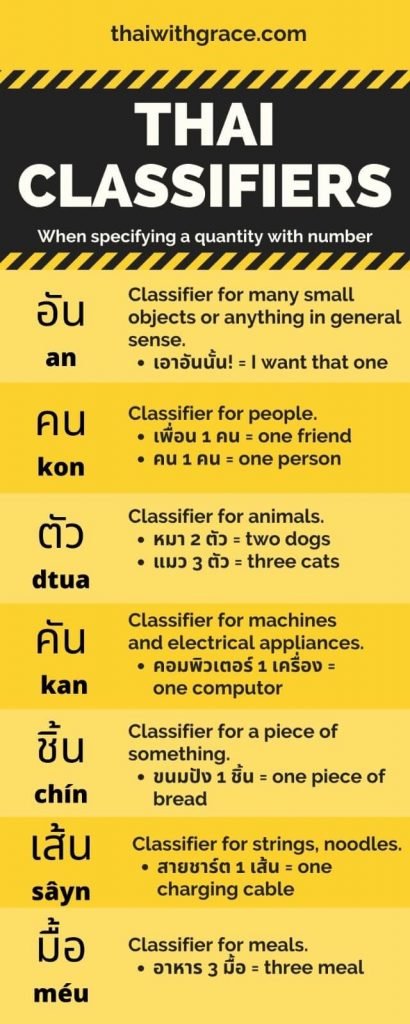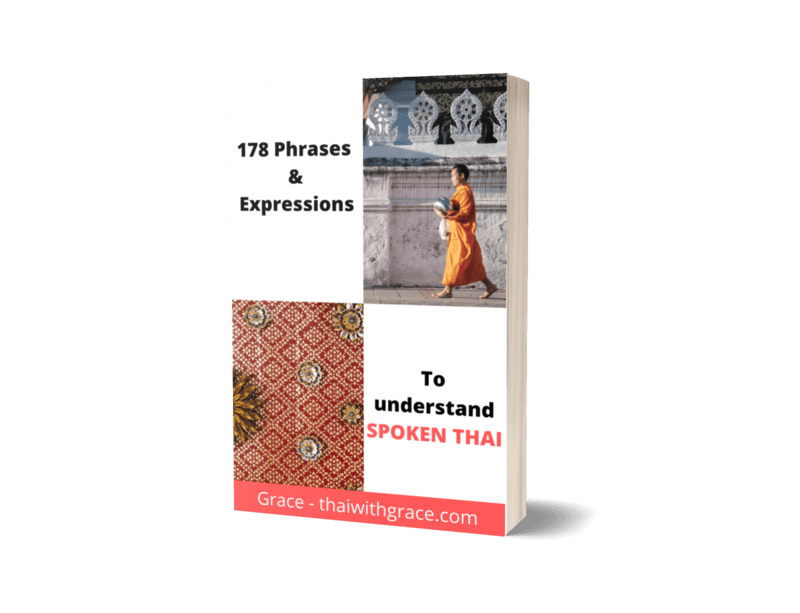Learning Thai Classifiers (ลักษณะนาม: lák-sà-nà-naam) is a very important part of learning Thai Grammar because they are used every day and used so much more often than in English. I will explain in a bit.
Technically, there are many Thai classifiers you will have to learn (see this list). In this article, I will explain the concept of classifiers, when to use them, and the most common classifiers that are the most useful.
The concept of Thai Classifiers
English actually has a very similar concept for many of its nouns.
- For example, in English, you can’t say “I have 5 water” but you can quantify water with a word like “glasses, cups, bottles” and say “I have 5 cups of water”.
- Another example is you can’t say “I have 20 foods” but you can quantify “food” by saying something like “I have 20 plates of food”.
- There are more examples like “I have 20 pairs of glasses” where you quantity “glasses” with the word “pair”
- In Thai you will always have to quantify the noun with a classifier.
When do you have to use Thai Classifiers?
1) You use Thai classifiers whenever you are quantifying or counting items.
Formula: Subject + number + classifier
Examples:
- เพื่อนสองคน (pêuuan sŏng kon)
Two friends - แม่หนึ่งคน (mâe nèung kon)
One mother
2) You use Thai Classifiers whenever you want to say “First, second, third, fourth” and so on.
Formula : Subject + classifier + ที่ (têe)+ number
Examples:
- รถคันที่หนึ่ง (rót kan têe nèung)
First car - รถคันที่สอง (rót kan têe sŏng)
Second car
3) When you ASK “how many?”.
Formula: subject + กี่ (gèe) + classifier
Examples:
- รถกี่คัน (rót gèe kan)
How many cars? - หมากี่ตัว (măa gèe dtuua)
How many dogs?
4) When you ask “which?”.
Formula: Subject + classifier + ไหน (năi)
Examples:
- คอมเครื่องไหน (kom krêuuang năi)
Which computer?
หนังสือเล่มไหน (năng-sĕu lêm năi)
Which book?
5) When you answer to “which” question with “this, that, that further away”.
Formula: Subject + classifier + นี้/นั้น/โน้น (née/nán/nóhn)
Examples:
- คอมเครื่องนี้ (kom krêuuang née)
This computer - หนังสือเล่มนั้น (năng-sĕu lêm nán)
That book - แมวตัวโน้น (maew dtuua nóhn)
That cat (further away)
6) When want to say “many” using “หลาย”.
Formula: Subject + หลาย (lăai) + classifier.
- มีผู้ชายหลายคน (mee pôo chaai lăai kon)
There are many men. - มีห้องนอนหลายห้อง (mee hông non lăai hông)
There are many bedrooms.
7) When you want to say “a few” using “ไม่กี่” (mâi gèe)
Formula: Subject + ไม่กี่ + classifier
Examples:
- มีผู้ชายไม่กี่คน (mee pôo chaai mâi gèe kon)
There are few men. - มีห้องนอนไม่กี่ห้อง (mee hông non mâi gèe hông)
There are few bedrooms.
Pattern for counting with Thai classifiers
The pattern for counting Thai Classifiers is to use the noun – followed by the quantity – followed by the classifier.
For example, “6 friends” in Thai would be เพื่อน หก คน (pêuan hòk kon) where เพื่อน is the noun meaning friend, หก is the quantity meaning 6 and คน is the classifier for people. So the literal translation in English is “friends 6 people”.
Most Common Thai Classifiers
The following are the Thai classifiers I use most often and the most common objects they quantify.
- อัน an (classifier for many small objects like dice, pliers, canes. You can also use it if you don’t know which classifier to use)
- คน kon (classifier for people)
- ตัว dtua (classifier for animals, letters, numbers, clothing that doesn’t come in pairs, chairs, tables)
- แก้ว gâew (classifier for glasses)
- จาน jaan (classifier for plates of food)
- เล่ม lâym (classifier for knives, books)
- คัน kan (classifier for cars and vehicles except boats or planes)
- แท่ง tâeng (classifier for bars and cylindrical objects like pencils)
- เครื่อง krêuang (classifier for machines and electrical appliances like computers, phones)
- ใบ bai (classifier for pieces of paper, documents)
- ชุด chút (classifier for a set or group of something or uniforms, bathing suits)
- แผ่น pàen (classifier for thin or flat objects, like CDs and slices of bread)
- เม็ด mét (classifier for seeds, pills, buttons)
- ชิ้น chín (classifier for a piece of something like 3 pieces of cake )
- หลัง lăng (classifier for a house)
- เส้น sâyn (classifier for strings, noodles)
- ลูก lôok (classifier for balls, fruits, and other small and round objects)
- ขวด kùat (classifier for bottles)
- ห้อง hông (classifier for rooms)
- มื้อ méu (classifier for meals)
If you don’t know which classifier to use I recommend using อัน (an). While it is technically wrong if you use it all the time it is the one I would consider as “all purpose” classifier. For example, if you don’t know the correct classifier for mirror, while the correct classifier is บาน (baan), if you didn’t know you can say อัน (an).
Examples
- I want 4 pineapples
ฉันเอาสับปะรด 4 ลูก
chăn ao sàp-bpà-rót sèe lôok - There are 2 men in the store
มีผู้ชาย 2 คนในร้าน
mee pôo chaai sŏng kon nai ráan - I drink 4 bottles of beer
ฉันดื่มเบียร์ 4 ขวด
chăn dèum bia sèe kùat - 3 plates of Pad Thai
ผัดไทย 3 จาน
pàt tai săam jaan - I eat 3 slices of cake
ฉันกินเค้ก 3 ชิ้น
chăn gin káyk săam chín - Today I had only 3 meals
วันนี้ฉันกินอาหารแค่สองมื้อ
wan née chăn gin aa-hăan kâe sŏng-méu
Examples when asking “which” questions
- Which one do you like?
คุณชอบอันไหน
kun chôp an năi - Which book will you bring? – Literally translates to : You will bring book (book classifier) which?
คุณจะเอาหนังสือเล่มไหน
kun jà ao năng-sĕu lâym năi
Or you can even omit the noun and just use the classifier because the noun is already implied. For example:
- Which car do you like? – Literally translates to : you like (car classifier) which?
คุณชอบคันไหน
kun chôp kan năi - Which book will you bring? Literally translates to : You will bring (book classifier) which?
คุณจะเอาเล่มไหน
kun jà ao lâym năi

Summary
There are many classifiers to learn, however, I recommend starting by learning the ones above which I think are the most common. With those, you will be able to correctly classify most everyday things. If you want to find a classifier you don’t know then I recommend this list.
If you don’t know which classifier to use I recommend you use อัน (an) (although it is technically wrong).

